|
|

This chapter describes the following tasks to help you find information about interfaces on your routers:
Once you have enabled the Interface Monitoring application in ISM, you can disable monitoring of individual interfaces when you set up the router or interface monitoring options. For information on setting up interface-specific management options, see the "Setting Up Interface-Specific Management Options" section.
ISM's architecture provides two layers of interface management control options---global and individual:
For information on setting up global interface monitoring options, see the "Setting Up Interface Monitoring Parameters" section.
For information on setting up interface-specific monitoring options, see the "Setting Up Interface-Specific Management Options" section.
To override some of the global management options and manage other aspects of the interface on that router, use the ISM : Interface Administration panel to specify options for individual interfaces in routers that are known to ISM.
To set up interface monitoring options for an individual interface, complete these steps:
Step 1 From the ISM : Monitoring Menu panel, type I and press Enter. The ISM : Interface List panel is displayed, showing routers grouped by interface type (Figure 6-1).
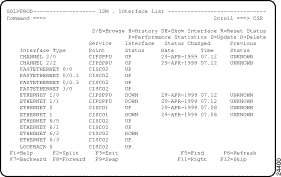
Step 2 On the ISM : Interface List panel, type U next to the name of the interface that you want to modify and press Enter.
The ISM : Interface Administration panel is displayed (Figure 6-2).
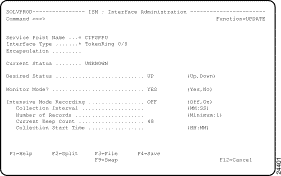
Step 3 To enable or disable interface monitoring, type Yes or No in the Monitor Mode field.
Step 4 To enable or disable intensive mode recording, type On or Off in the Intensive Mode Recording field.
For further information about setting up intensive mode recording, see the "Setting Up Interface-Specific Management Options" section.
Step 5 Press F3 to file the changes that you have made.
Use the ISM : Interface Administration panel (Figure 6-2) to set up the options for intensive mode recording (IMR), that is, collecting interface statistics at high rates.
 | Warning IMR settings are not saved when you restart your ISM region. |
To set up intensive mode recording, complete the following steps on the ISM : Interface Administration panel (Figure 6-2):
Step 1 To enable intensive mode recording, type On in the Intensive Mode Recording field.
Step 2 To set an interval for statistics to be collected for this interface, type a value in the Collection Interval field.
Step 3 To set a wrap count for statistics to be collected for this interface, type a value in the Number of Records field.
Step 4 To set a start time for statistics to be collected for this interface, type a value in the Collection Start Time field.
Step 5 Press F3 to file the changes that you have made.
You can disable interface archiving on a global or individual router basis. For information about disabling router interface archiving see the "Disabling Router Interface Archiving" section.
When you configure the ISM management environment, you specify the types of interfaces that you want to monitor and the interval (in hours and minutes) at which you want router interfaces monitored. For more information on selecting the interfaces that are enabled for monitoring by ISM, see the "Setting Up ISM to Monitor Interfaces" section in this chapter.
Once ISM has been set up to monitor interfaces, you can perform the following monitoring operations for interfaces and view status descriptions:
Complete the following tasks to display a list of interfaces configured in a specific router:
Step 1 On the ISM : Router List panel (Figure 6-3), type I next to the router for which you want to view interface information and press Enter. The ISM : Interface List panel is displayed (Figure 6-4) for the selected router.
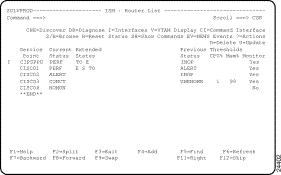
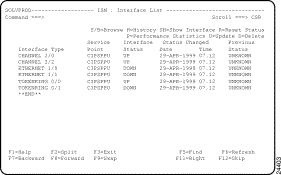
Step 2 To access the ISM : Interface Administration panel (Figure 6-2) for a particular interface, type S or B next to the interface that you want to view and press Enter.
Step 3 Press F3 to exit from this panel.
ISM provides two ways for you to monitor interfaces of a particular type:
Step 1 From the ISM : Monitoring Menu panel, type S in the Select Option field and press Enter. The ISM : Status Summary panel (Figure 6-5) is displayed, showing the total number of interfaces being monitored by type and the subtotals of those interfaces categorized by status.
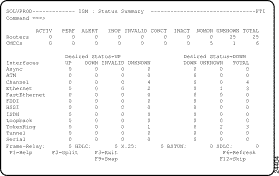
Step 2 If you want to refresh this display, press F6.
Step 1 From the ISM : Monitoring Menu panel, type I in the Select Option field
Step 2 Type a value in the Interface Type and press Enter. The ISM : Interface List panel is displayed (Figure 6-6), showing interfaces of the specified type for all routers being monitored by ISM.
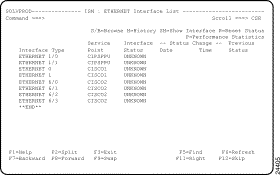
Step 3 To view further details of a specific interface for a specific router, type one of the displayed action codes next to the interface and press Enter.
The color in which an interface is displayed on the ISM : Interface List panel (Figure 6-1) indicates the status of that interface.
Table 6-1 lists the color and definition of each status.
| Color | Status | Definition |
Green | UP DOWN | Interfaces that are Up with desired status Up. Interfaces that are Down with desired status Down. |
Red | DOWN UP | Interfaces that are Down with desired status Up. Interfaces that are Up with desired status Down. |
Turquoise | INVALID | Interface defined to ISM but does not exist in router. |
Blue | NOMON | Interface monitoring and history are disabled for the interface. |
White | UNKNOWN | Interface is awaiting its first poll or ISM was unable to determine the status of the interface. |
To run the show interface command for a selected interface on the ISM : Interface List panel (Figure 6-4), type SH next to the interface name and press Enter. The ISM : Command Interface panel is displayed (Figure 6-7), showing configuration details of the selected interface.
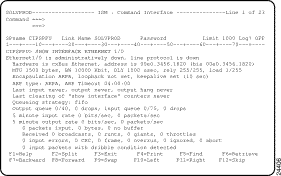
To view history statistics for a particular interface in a router from the ISM : Interface List panel (Figure 6-4), type H next to the interface name and press Enter. The history statistics records logged for the selected interface are displayed on the ISM : Interface Statistics History panel (Figure 6-8). Press F11 to view further interface statistics.
For information about the statistics on this panel, press F1 for help.
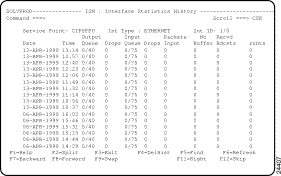
To delete interface history records for this interface, perform the following steps:
Step 1 Press F4.
The ISM : Interface Statistics History Delete panel is displayed, prompting you to confirm or cancel your delete request.
Step 2 Press F6 to confirm the delete.
ISM displays a message confirming that the interface statistics history records for the selected interface have been deleted.
To view performance data for a particular interface in a router from the ISM : Interface List panel (Figure 6-4), type P next to the interface name and press Enter. The performance statistics records logged for the selected interface are displayed on the ISM : Interface Performance History panel (Figure 6-9).
For information about the statistics on this panel, press F1 for help.
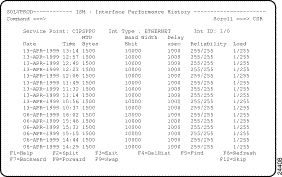
The record wrap counts are specified on the ISM : Database Parameters panel (see the "Setting Up ISM Database Parameters" section).
To delete interface statistics history records for an interface, perform the following steps:
Step 1 On the ISM : Interface Statistics History panel, press F4. The ISM : Interface Statistics History Delete panel is displayed, prompting you to confirm or cancel your delete request.
Step 2 Press F6 to confirm the delete. ISM displays a message confirming that the interface statistics history records for the selected interface have been deleted.
To delete interface performance history records for an interface, perform the following steps:
Step 1 On the ISM : Interface Performance History panel, press F4. The ISM : Interface Performance History Delete panel is displayed, prompting you to confirm or cancel your delete request.
Step 2 Press F6 to confirm the delete.
ISM displays a message confirming that the interface performance history records for the selected interface have been deleted.
![]()
![]()
![]()
![]()
![]()
![]()
![]()
![]()
Posted: Tue Aug 24 12:08:09 PDT 1999
Copyright 1989-1999©Cisco Systems Inc.